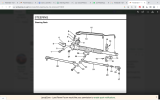Recently I have been having issues with my beloved Freelander 1 TD4 2006.
The E Torx bolt which fixes the driver’s side track rod (no. 28 in the attached image) broke in the steering rack.
We therefore had to remove the steering rack to remove the broken bit of bolt.
Before refitting the steering rack we checked that the hole (where there bolt fits) was not damaged and the bolt fitted fully.
We bought a new E Torx bolt and refitted the steering rack. The E Torx bolts were fitted with blue thread lock and one washer each.
We now have the following 2 problems:
1) When the E Torx bolts are fully tightened it’s impossible to turn the steering wheel completely to the right or left. However, when the bolts are slackened slightly the steering wheel can be turned fully left and right. How do we get that steering wheel to turn completely when the bolts are fully tightened, as they should be?
2) After numerous turns of the steering wheel we now have a new problem whereby on turning the steering wheel:
- the track rods no longer move but instead
- the right side of steering rack (around the rack mounting bracket area - no.16 in attached image) moves left or right depending on the direction the steering wheel is turned, while the rest of the steering rack remains fixed
- when the vehicle is jacked up so that the front wheels are off the ground and the steering wheel is turned, the track rods move left and right and the entire steering rack remains fixed.
My understanding is that the entire steering rack should remain fixed and just the track rods pulled left or left when turning the steering wheel. How do we ensure that the entire steering rack remains fixed when the steering wheel is turned?
The E Torx bolt which fixes the driver’s side track rod (no. 28 in the attached image) broke in the steering rack.
We therefore had to remove the steering rack to remove the broken bit of bolt.
Before refitting the steering rack we checked that the hole (where there bolt fits) was not damaged and the bolt fitted fully.
We bought a new E Torx bolt and refitted the steering rack. The E Torx bolts were fitted with blue thread lock and one washer each.
We now have the following 2 problems:
1) When the E Torx bolts are fully tightened it’s impossible to turn the steering wheel completely to the right or left. However, when the bolts are slackened slightly the steering wheel can be turned fully left and right. How do we get that steering wheel to turn completely when the bolts are fully tightened, as they should be?
2) After numerous turns of the steering wheel we now have a new problem whereby on turning the steering wheel:
- the track rods no longer move but instead
- the right side of steering rack (around the rack mounting bracket area - no.16 in attached image) moves left or right depending on the direction the steering wheel is turned, while the rest of the steering rack remains fixed
- when the vehicle is jacked up so that the front wheels are off the ground and the steering wheel is turned, the track rods move left and right and the entire steering rack remains fixed.
My understanding is that the entire steering rack should remain fixed and just the track rods pulled left or left when turning the steering wheel. How do we ensure that the entire steering rack remains fixed when the steering wheel is turned?

